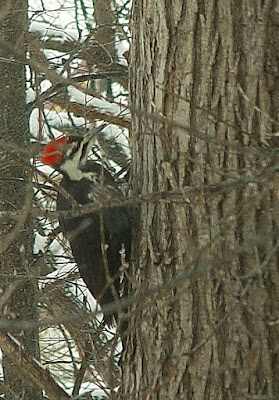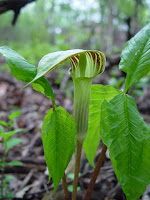5/22/2016
feeding baby birds
5/21/2016
furnishing a nestbox: House Wren
A House Wren Troglodytes aedon carries twigs, one at a time, to a nest box.
The male works until he fills the box with twigs, leaving a small cup or cavity.
The female adds soft grasses, fur, feathers, and junk to line the cup where she will lay her eggs.
Below, we peek inside another nest box containing a cozy nest for seven wren eggs.
The female will incubate the eggs for about 2 weeks.
5/20/2016
woods in bloom
top left: Arisaema triphyllum Jack-in-the-Pulpit; top middle: Geranium maculatum Wild Geranium; top right: Asarum canadense Wild Ginger; and a view of Aquilegia Columbine, all blooming now in the wild wild woods.
5/15/2016
nest cavity
A pair of Downy Woodpeckers decided the tree stump near the feeder garden is a good prospect for their 2016 nest cavity. They've been excavating into the old tree for a few weeks. Today, the female peeked out long enough for a look around; it was long enough for us to get a look at her!
5/14/2016
new hatchlings
Seven little Black-capped Chickadee eggs hatched in the last few days. The nestbox cam caught a snapshot when they were all gaping for food.
5/09/2016
4/30/2016
NestWatch
NestWatch, the citizen science project!
We look for cavity-nesting birds in trees as well as in nest boxes. A pair of Downy Woodpeckers has been excavating this hole overlooking the feeder gardens. Both will work at the nesting hole for up to three weeks. Their intent is to make a cozy cavity up to a foot deep in which to lay their eggs. They will line the bottom with woods chips. "Downies" usually lay 3 to 8 eggs; the eggs are white so the parents can see them in their dark cavity.
NestWatch

NestWatch!
Several nest boxes are in the yard and woods, waiting for cavity-nesting birds. Each box has a small video cam so we can watch the nest without disturbing the birds.
In this box a thick layer of moss was installed; then we saw grasses being laid in, re-arranged daily. The chickadee evidently laid her eggs over the past week, burying each one deep under the grass away from predators. Today, she started incubating them by gathering all seven and sitting close on them. A short flight outside revealed this treasure.
4/28/2016
4/19/2016
deciduous conifers
These new cones and needle-like leaves are emerging on our non-native European Larch Larix decidua. The old cones (at top in the photo) commonly remain on the tree for many years, turning dull grey-black. From a distance, the new cones look like rosey flowers on the Larch tree.
native deciduous conifers
Needle-like leaves (right) emerging in clusters, and new cones developing on the deciduous conifer American Larch Larix laricina. The seed cones will become 3/4" long, bright rosey red, and mature to lustrous brown scales containing the seeds.
The needle-leaves grow in dense clusters spirally on branches. They will glow bright green all summer, then turn golden before dropping in winter.

4/17/2016
viburnum
A very few of last year's berries remain on the American cranberry bush as colorful background for the new buds of this year's leaves. This Viburnum trilobum 'Hahs' produces high-pectin berries that hold well into winter and provide nourishing food for birds during cold months when insects are scarce.
4/15/2016
bloodroot
 Bloodroot. Thick juicy underground stems. Sap of blood red. Sanguinaria, its fitting Latin name, meaning blood red. But walking in the woods, you'll see innocent white flowers on pinkish stalks with a bright attractive center. The stem, leaf, and flower bud (in a neat wrapped bundle) are pushed up together through early Spring leaf litter. The delicate flower only lasts a day or two. Bees pollinate bloodroot. Once blossoming, it develops pod-like capsules that contain seeds. Ants harvest and spread the mature seeds.
Bloodroot. Thick juicy underground stems. Sap of blood red. Sanguinaria, its fitting Latin name, meaning blood red. But walking in the woods, you'll see innocent white flowers on pinkish stalks with a bright attractive center. The stem, leaf, and flower bud (in a neat wrapped bundle) are pushed up together through early Spring leaf litter. The delicate flower only lasts a day or two. Bees pollinate bloodroot. Once blossoming, it develops pod-like capsules that contain seeds. Ants harvest and spread the mature seeds.3/29/2016
alarm calls in the woods
The raptor Coopers Hawk came to the water bowl for a drink, then dropped his tail feathers into the cold water while looking around for dinner.
All the songbirds freeze in place and get very quiet when a raptor appears. They don't want to be seen or heard, for fear of becoming a raptor's meal.
Read a fascinating article about alarm calls that birds make to alert others of a raptor hunting in the area . . .
https://www.allaboutbirds.org/look-out-the-backyard-bird-alarm-call-network/
3/23/2016
3/04/2016
feathers of Downy Woodpeckers
Downy woody Picoides pubescens
is the smallest woodpecker of the wild wild woods. We see two or three at a time, searching up and down the trees for insects within the folds of bark.
The nasal bristles (stiff yellow feathers above the beak) keep wood crumbs out of the bird's nasal openings as he searches for food or excavates a nest hole in a tree.
Downy Woodpeckers stop at the water bowl too, where this tiny feather was left behind. It may be from the top of this male's head.
a murder of crows

This hawk was gliding over the feeder garden looking for breakfast. The American Crows, who had been snatching peanuts from the tray feeder, gave chase. The hawk landed on a nearby roof. The crows dive-bombed in an effort to scare the hawk away. The hawk calmly waited, squawked a few times, then lifted off towards the river for a better chance at hunting.
3/03/2016
feet and beak
We heard the shrill whinnying calls of the male Pileated Woodpecker Dryocopus pileatus as he made his way through the woods, then came to the suet block for breakfast. He thrust his strong beak into the food, scattering some crumbs to the ground and gulping a few pieces into his gullet. Once he had a mouthful, he went to a nearby tree where he used the rough bark to hold the suet as he consumed it. His tongue has a spear-like tip bearing backward-facing barbs that allow him to lick food items from between the folds of tree bark. Pileated Woodpeckers' favorite food is carpenter ants; also other ants, wood boring beetle larvae, termites, flies, caterpillars, cockroaches, grasshoppers, wild fruits and nuts.
Woodpeckers have zygodactyl feet (two toes facing forward, one facing back) and allows these birds to easily climb and grasp bark, tree branches and other structures.
2/14/2016
GBBC
19th annual Great Backyard Bird Count -- in the wild wild woods today, Mourning Dove, Pileated Woodpecker, Red-bellied Woodpecker, Hairy Woodpecker, Downy Woodpecker, American Crow, Bluejay, Black-capped Chickadee, White-breasted Nuthatch, Junco, Northern Cardinal, European Starling, House Finch, Goldfinch, House Sparrow. Lastly, at dusk, this Sharp-shinned Hawk came by to get his name on the list.
2/05/2016
winter starlings
These two European Starlings have been coming to the suet feeders for a week or so. Their Latin name Sturnus vulgaris is fitting, since these non-natives are considered a vulgar nuisance when they mob lawns in big, noisy flocks. They appear black, but up close their feathers are dazzling iridescent blue, purple, gold, and green. Fortunately, just these two so far near the wild wild woods . . .
Studies of Starlings' mob movements have found that starling flocks model a complex physical phenomenon, seldom observed in physical and biological systems, known as scale-free correlation. Read more at starling murmurations
2/02/2016
redpolls
Today, just as the heavy snow started falling, two Redpolls showed up at the feeder garden. They darted often back into the woodland edge for cover, but snatched many seeds from the tray alongside the Chickadees, Cardinals, and Juncos.
Redpolls breed worldwide in the far northern latitudes. But they come "south" when food is unpredictable in late January. Their winter range is extremely variable (as far south as Iowa or Missouri) when these little birds seek food from open woodlands, scrubby and weedy fields, or backyard feeders.
They can survive temperatures of 65F below zero degrees: they will add about 31 percent more plumage by weight, and tunnel into snow for shelter.
1/09/2016
the old fence row
In gardening season,
I found buried several
pieces of the old barbed
wire that used to be the
fence row when this was
farmed land.
The pieces stand by,
relieved of duty.
1/08/2016
snow on Joe Pye Weed
The seedheads of Joe Pye Weed stand at the edge of the woods. When nibbling these seeds, the Goldfinches nearly disappear by blending in with the dried leaves and seed pods. With a blanket of sticky snow, the pods became "cotton balls" overnight!
1/01/2016
Pileated woodpeckers
 |
| Female: red crest on back half of head |
 |
| Male: red crest on entire head plus red "moustache" |
Every week we see a Pileated Woodpecker Dryocopus pileatus in the woods, or on the suet feeders at the edge of the woods. Today both a male and female were searching up and down the tree trunks for insects. Each bird is 15 to 20" long, with a wingspan of 26 to 29". A pair may stay together year around; they'll begin excavating a nesting hole in late March.
Subscribe to:
Posts (Atom)


























